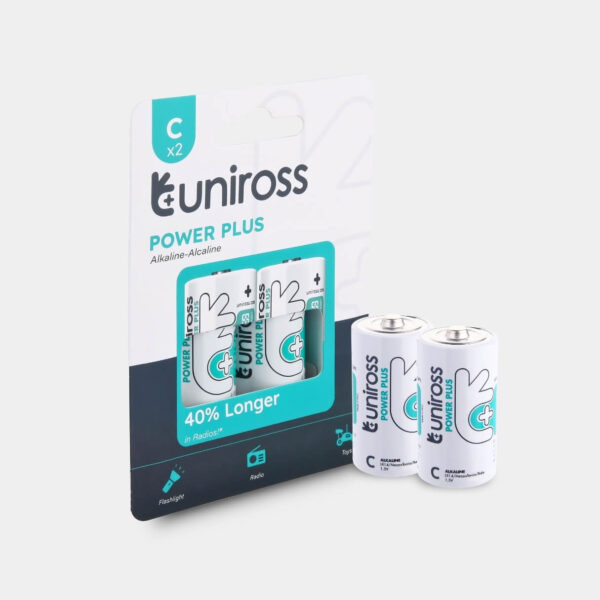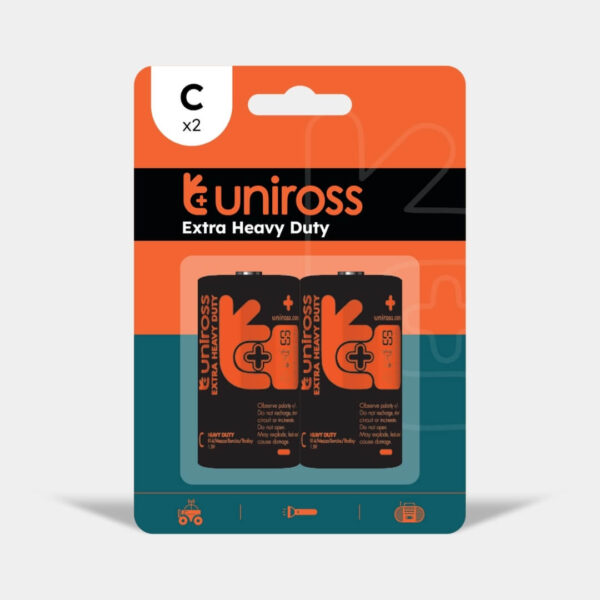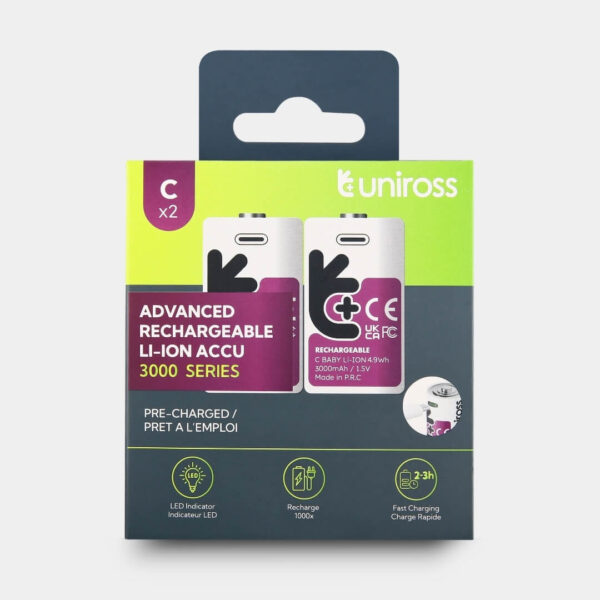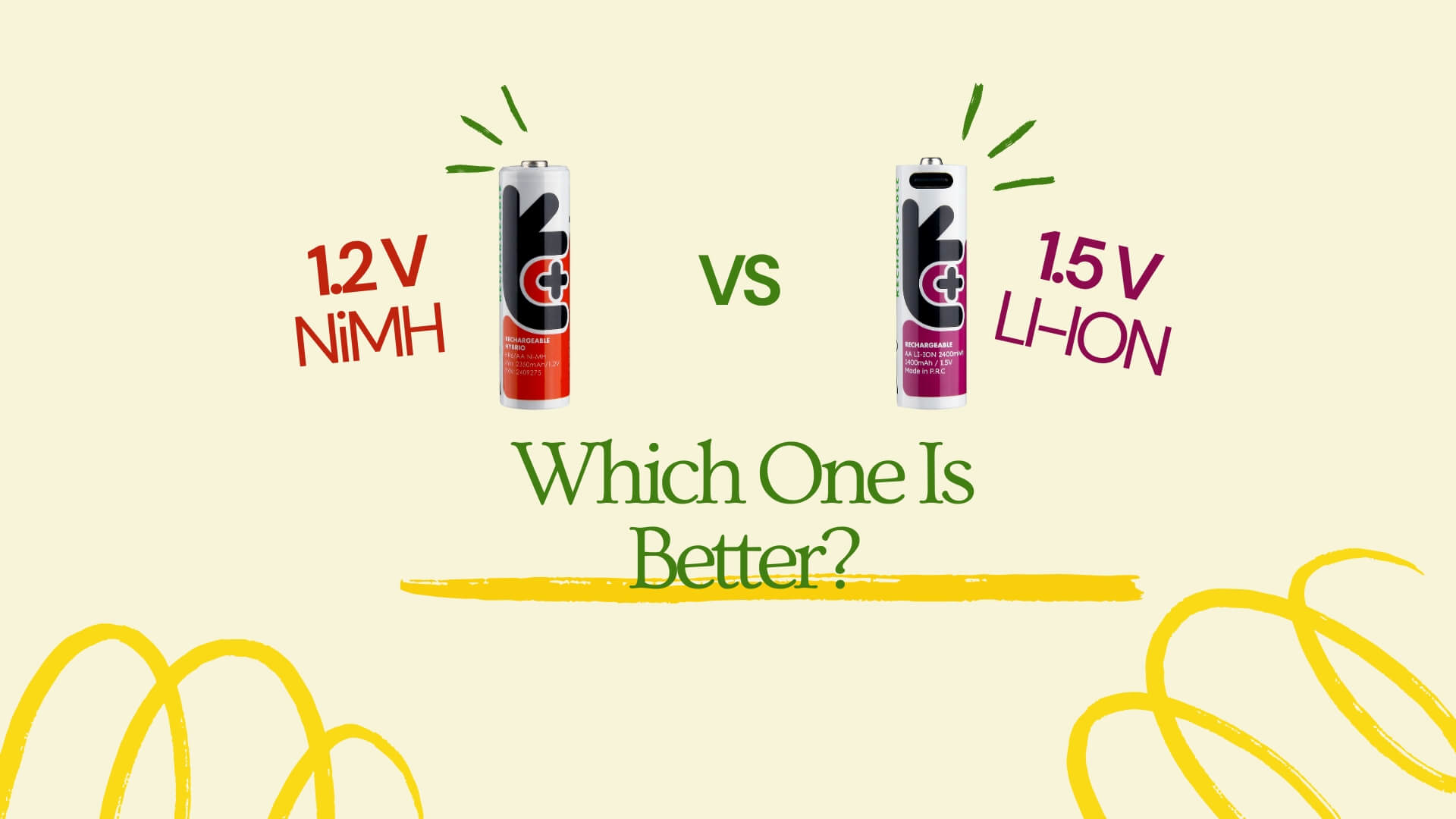C battery, also known as C‑cell, R14, or LR14, is a standard cylindrical dry cell that falls between AA and D batteries in terms of size. C battery dimensions are approximately 50 mm (1.97 inches) in length and 26.2 mm (1.03 inches) in diameter. This medium size makes it ideal for devices that require more power than AA batteries can provide but don’t need the larger capacity of D batteries.
Types & Chemistry of C Batteries
Primary (Non-Rechargeable) C Batteries
Primary batteries are designed for single-use and are not meant to be recharged.
Alkaline C Batteries
Alkaline C batteries are popular for their affordability and wide availability. They provide reliable power for everyday devices and have a long shelf life.
- Voltage: 1.5V
- Capacity: Up to 8,000mAh
- Shelf Life: Approximately 7–10 years
- Best For: High-drain devices like flashlights, toys, and radios.
Zinc-Carbon C Batteries
Zinc-carbon batteries are cost-effective but have a shorter shelf life and lower capacity compared to alkaline batteries.
- Voltage: 1.5V
- Capacity: Up to 3,800mAh
- Shelf Life: Approximately 3–5 years
- Best For: Low-drain devices like clocks and remote controls.
Secondary (Rechargeable) C Batteries
Secondary batteries can be recharged and used multiple times, offering long-term cost savings and environmental benefits.
Nickel-Metal Hydride (NiMH) C Batteries
NiMH C batteries are eco-friendly and cost-effective over time. They are suitable for devices that are used frequently and require regular battery replacement.
- Voltage: 1.2V
- Capacity: Up to 6,000mAh
- Recharge Cycles: Approximately 500–1,000 cycles
- Best For: Devices with moderate power consumption.
Lithium C USB-C Rechargeable Batteries
USB-C rechargeable lithium-ion C batteries offer the convenience of direct charging via USB-C ports. These batteries provide a stable 1.5V output, ensuring reliable performance for high-drain devices.
- Voltage: 1.5V
- Capacity: Up to 5,000mWh
- Recharge Cycles: Approximately 1,000–1,200 cycles
- Charge Time: Approximately 2 hours
- Best For: High-drain devices and users seeking convenient charging solutions.
Voltage, Capacity & Weight: Understanding C Battery Performance
When selecting a C battery for your device, it’s essential to consider its voltage, capacity, and weight. These factors directly influence the battery’s performance, runtime, and suitability for specific applications.
Voltage
- Standard Voltage: Most C batteries, including alkaline and zinc-carbon types, provide a nominal voltage of 1.5V.
- Rechargeable Variants: Rechargeable C batteries, such as NiMH (Nickel-Metal Hydride) types, typically offer a slightly lower voltage of 1.2V. However Uniross USB-C rechargeable C Battery provides a nominal voltage of 1.5V
Capacity
- Alkaline C Batteries: These batteries generally offer a capacity ranging from 6,000 to 8,000 mAh, making them suitable for high-drain devices.
- NiMH Rechargeable C Batteries: Typically provide a capacity between 4,000 to 6,000 mAh and can be recharged approximately 500 to 1,000 times, offering long-term cost savings and environmental benefits.
- Zinc-Carbon C Batteries: These are less common today but usually offer a capacity of around 3,800 mAh, suitable for low-drain devices.
Common Devices Powered by C Batteries
C batteries are predominantly used in medium-drain devices that demand consistent power over extended periods.
Some of the most common applications include:
- Flashlights & Lanterns: Ideal for camping, emergency kits, and outdoor activities, providing reliable illumination.
- Toys: Powering motorized toys, remote-controlled cars, and educational gadgets.
- Portable Radios: Ensuring uninterrupted listening during outdoor events or power outages.
- Musical Instruments: Used in electronic keyboards and other battery-operated instruments.
- Medical Devices: Powering equipment like nebulizers and portable oxygen concentrators.
- Emergency Lighting: Providing backup power for safety lights during outages.
- Smoke Detectors: Ensuring continuous monitoring for fire safety.
Safety & Storage Tips: Ensuring Longevity and Safe Use of C Batteries
Proper handling and storage of C batteries are essential to maximize their lifespan, ensure safety, and maintain optimal performance. Whether you’re using traditional alkaline, NiMH rechargeable, or USB-C rechargeable batteries, adhering to best practices can prevent hazards and enhance reliability.
General Battery Safety Guidelines
- Avoid Mixing Battery Types: Do not mix different chemistries (e.g., alkaline with NiMH) or new with used batteries in the same device. This can lead to leakage, reduced performance, or even damage to the device.
- Handle with Care: Always handle batteries with clean, dry hands. Avoid dropping or crushing them, as physical damage can compromise their integrity and safety.
- Keep Out of Reach of Children and Pets: Batteries, especially small ones, can pose choking hazards. Store them in secure locations away from children and pets.
Optimal Storage Conditions
- Cool, Dry Environment: Store batteries in a cool, dry place at room temperature. Avoid areas with high humidity or extreme temperatures, such as attics or garages, as these conditions can degrade battery performance and safety.
- Use Non-Conductive Containers: Store batteries in their original packaging or a dedicated battery storage case made of non-conductive material. This prevents accidental short circuits and keeps batteries organized.
- Avoid Refrigeration: Refrigerating batteries is generally unnecessary and can lead to condensation, potentially causing short circuits or leakage.
Rechargeable C Battery Storage (e.g., NiMH, USB-C)
- Partial Charge for Storage: For NiMH rechargeable batteries, it’s recommended to store them at about 40% charge to prevent deep discharge, which can shorten their lifespan.
- Regular Use and Charging: Rechargeable batteries should be used regularly and charged according to the manufacturer’s instructions. Prolonged inactivity can lead to capacity loss.
- Monitor for Signs of Wear: Regularly inspect rechargeable batteries for any signs of swelling, leakage, or corrosion. Replace them if any abnormalities are detected.
Disposal and Recycling
- Never Dispose in Regular Trash: Batteries should not be disposed of in regular household trash due to environmental hazards and fire risks.
- Use Authorized Recycling Centers: Utilize certified recycling programs like Call2Recycle or Earth911 to find appropriate drop-off locations for used batteries.
- Follow Local Regulations: Be aware of and adhere to local regulations regarding battery disposal and recycling to ensure compliance and environmental responsibility.







